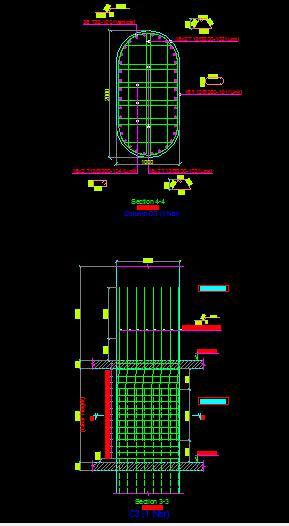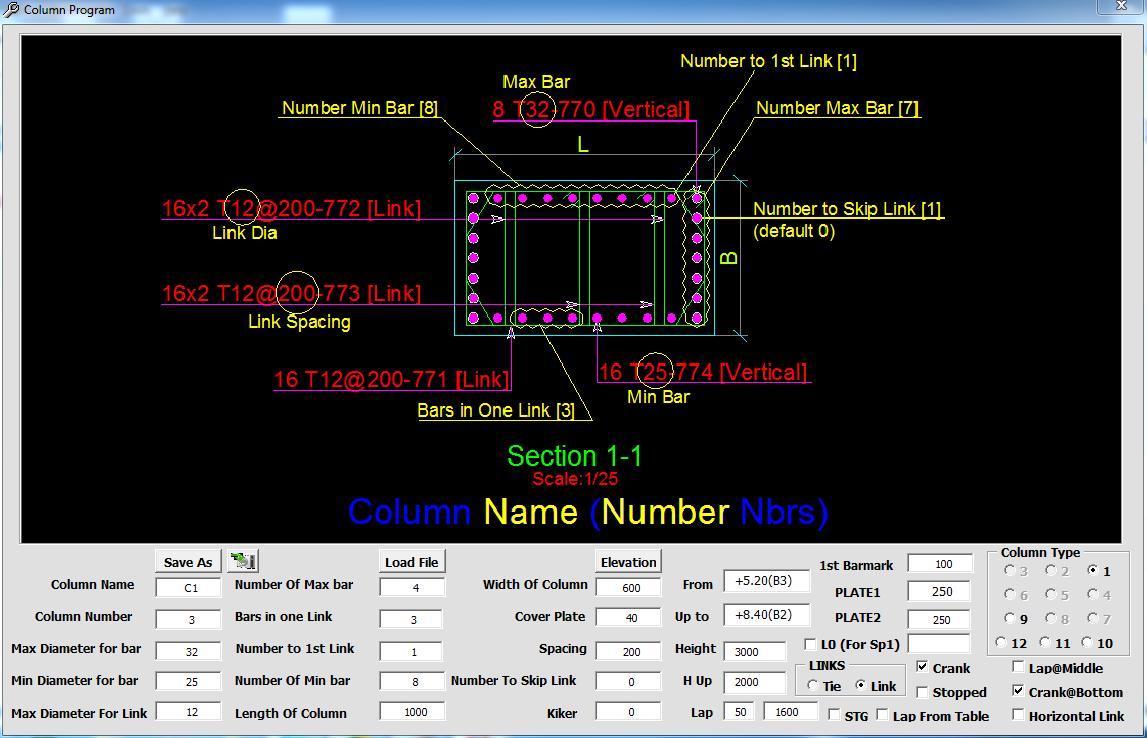
Columns:
To get Column rebar click columns
button on the main window.
Save as button: to save input files
with extension hms. Output file will have the name inserted in input
file.
Load button: to reload old input
files for changing or modifying.
Elevation/plan button: to show plan
or elevation on the input window
In Columns
Program you can find five type of columns (Type 1, Type 9, Type 10, Type 11,
Type 12). Choose the type that match columns you want.
1) Type 1: Shape
of the column in type 1 is rectangular.
The variables
are:
1.1 Name of the
column: column name,
1.2 Number of similar columns:
Column Number,
1.3 Max diameter for Bar: value of
column steel bar diameter on the short side,
1.4 Min diameter for Bar: value of
column steel bar diameter on the long side,
1.5 Max diameter for link : value
of maximum link diameter in the column reinforcement,
1.6 Number of max bar: total number
of steel bars in the column on the short side,
1.7 Number of Min bar: total number
of steel bars in the column on the long side excluding the two side
bars,
1.8 Bar in one link: the number of
vertical bars will be included in each interior link on one
side,
1.9 Number to 1st link: starting
from the second vertical bar on the long side of the column, minimum value is
1
Number to 1st link = 1 if second
vertical steel bar is not included in first interior link
Number to 1st link = 2 if third
vertical steel bar is not included in first interior link
1.10 column dimensions: Length of
column and Width of column,
1.11 cover plate: value of concrete
cover for column,
1.12 spacing: value of space
between links,
1.13 Number to skip link: starting
from the second vertical bar on the short side of the column
Number to skip link = 0 if the
second vertical bar is not included in the trapezoidal
link
Number to skip link = 1 if both
second and third vertical bars is not included in the trapezoidal
link
1.14 Kicker: the value of concrete
height above slab after which the column will start
Kicker = 0 if column start straight
from the slab,
1.15 From: level of the lower
slab,
1.16 Up to: level of the upper
slab,
1.17 H up: height of the elevation
above the upper slab,
1.18 Height : Value of floor height
,
1.19 Lap: There are two cells. In
the first one insert number which is multiplied with the vertical diameter value
to result in the value of vertical bars overlapping in the second cell
automatically,
1.20 starting number of Bar Mark (1st barmark),
1.21 Plate 1: thickness of lower
slab,
1.22 Plate 2: thickness of upper
slab,
1.23 L0
( For SP1 ) :
Tick L0 if there is two spacing regarding the
link reinforcement, insert the value of intensification distance for the link
reinforcement ( the default value = 1/6* Column height ),
1.24 Link: Pick
link or tie to choose reinforcement rings type,
1.25 Crank: Pick crank if vertical
bars is to be cranked,
1.26 Stopped: Pick Stopped if the
column is stopped at the upper slab,
1.27 Lap from table: Pick lap from
table if overlapping equal constant value from given
table,
1.28 Lap @ middle: Pick Lap @
middle if overlapping location in the middle of column's
height,
1.29 Crank @ Bottom: Pick Crank @
Bottom if vertical bars is cranked at the level of lower
slab,
1.30 Horizontal Link: Pick Horizontal Link if there is links reinforcement
along the other side of column ( the long side ),
1.31 STG: Pick STG if the
overlapping is staggered one by one not in the same location ( with difference
of one overlap between each two following bars)
Input File for Type 1 :

Output file for Type 1 :
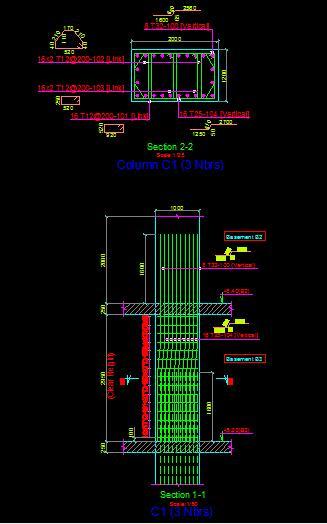
2) Type 9: Shape of the column in type 9 is
rectangular.
The variables
are:
2.1 Name of the
column: column name,
2.2 Number of similar columns:
Column Number,
2.3 Max diameter for Bar: value of
column steel bar diameter on the short side,
2.4 Min diameter for Bar: value of
column steel bar diameter on the long side,
2.5 Max diameter for link: value of
maximum link diameter in the column reinforcement,
2.6 Number of max bar: total number
of steel bars in the column on the short side,
2.7 Number of Min bar: total number
of steel bars in the column on the long side excluding the two side
bars,
2.8 Bar in one link: the number of
vertical bars will be included in each interior link on one
side,
2.9 Number to skip 1st link:
starting from the second vertical bar on the long side of the column, minimum
value = 0
Number to skip 1st link = 0 if
second vertical steel bar is included in first interior
link
Number to skip 1st link = 1 if
second vertical steel bar is not included in first interior
link
Number to skip 1st link = 2 if
third vertical steel bar is not included in first interior
link
2.10 column dimensions: Length of
column and Width of column,
2.11 cover plate: value of concrete
cover for column,
2.12 spacing: value of space
between links,
2.13 Bars in horizontal Link:
number of vertical bars on one side included in the link on the long
side,
2.14 Kicker: the value of concrete
height above slab after which the column will start
Kicker = 0 if column start straight
from the slab,
2.15 From: level of the lower
slab,
2.16 Up to: level of the upper
slab,
2.17 H up: height of the elevation
above the upper slab,
2.18 Height: Value of floor
height,
2.19 Lap: There are two cells. In
the first one insert number which is multiplied with the vertical diameter value
to result in the value of vertical bars overlapping in the second cell
automatically,
2.20 starting number of Bar Mark (1st barmark),
2.21 Plate 1: thickness of lower
slab,
2.22 Plate 2: thickness of upper
slab,
2.23 L0 (For SP1
) : Tick L0 if there is two spacing regarding the link reinforcement, insert the
value of intensification distance for the link reinforcement ( the default value
= 1/6* Column height ),
2.24 Link: Pick
link or tie to choose reinforcement rings type,
2.25 Crank: Pick crank if vertical
bars is to be cranked,
2.26 Stopped: Pick stopped if the
column is stopped at the upper slab,
2.27 Lap from table: Pick lap from
table if overlapping equal constant value from given
table,
2.28 Lap @ middle: Pick Lap @
middle if overlapping location in the middle of column's
height,
2.29 Crank @ Bottom: Pick Crank @
Bottom if vertical bars is cranked at the level of lower slab,
2.30 Horizontal
Link: Pick Horizontal Link if there is links reinforcement along the other side
of column ( the long side ),
2.31 STG: Pick
STG if the overlapping is staggered one by one not in the same location ( with
difference of one overlap between each two following bars).
Input File for Type 9 :

Output File for type 9 :

3) Type 10: Shape of the column in type 10 is
circular.
The variables
are:
3.1 Name of the
column: column name,
3.2 Number of similar columns:
Column Number,
3.3 Max diameter for Bar: value of
column steel first layer bar diameter (external layer),
3.4 Min diameter for Bar: value of
column steel second layer bar diameter (internal layer),
Min diameter for Bar = 0 if there
is no second (internal) layer,
3.5 Max diameter for link: value of
maximum link diameter in the column reinforcement,
3.6 Number of max bar: total number
of steel bars in the column in the external layer,
3.7 Number of Min bar: total number
of steel bars in the column in the internal layer,
3.8 Length of column: Diameter of
column,
3.9 cover plate: value of concrete
cover for column,
3.10 spacing: value of space
between links,
3.11 Kicker : the value of concrete
height above slab after which the column will start
Kicker = 0 if column start straight
from the slab,
3.12 From: level of the lower
slab,
3.13 Up to: level of the upper
slab,
3.14 H up: height of the elevation
above the upper slab,
3.15 Height: Value of floor
height,
3.16 Lap: There are two cells. In
the first one insert number which is multiplied with the vertical diameter value
to result in the value of vertical bars overlapping in the second cell
automatically,
3.17 starting number of Bar Mark
(1st barmark),
3.18 Plate 1: thickness of lower
slab,
3.19 Plate 2: thickness of upper
slab,
3.20 L0 (For SP1 ) : Tick L0 if there is two spacing
regarding the link reinforcement, insert the value of intensification distance
for the link reinforcement ( the default value = 1/6* Column height ),
3.21 Link: Pick link or tie to
choose reinforcement rings type,
3.22 crank: Pick crank if vertical
bars is to be cranked,
3.24 Stopped: Pick stopped if the
column is stopped at the upper slab,
3.25 Lap from table: Pick lap from
table if overlapping equal constant value from given
table,
3.26 Lap @ middle: Pick Lap @
middle if overlapping location in the middle of column's
height,
3.27 Crank @ Bottom: Pick Crank @
Bottom if vertical bars is cranked at the level of lower
slab,
3.31 STG: Pick STG if the
overlapping is staggered one by one not in the same location ( with difference
of one overlap between each two following bars).
Input File for Type 10 :

Output file for Type 10 :

4) Type 11:
Shape of the column in type 11 is curved.
The variables
are:
4.1 Name of the
column: column name,
4.2 Number of similar columns:
Column Number,
4.3 Max diameter for Bar: value of
column steel bar diameter on the short side,
4.4 Radius: value of column curved
side radius,
4.5 Max diameter for link: value of
maximum link diameter in the column reinforcement,
4.6 Number of max bar: total number
of steel bars in the column on the short side,
4.7 Number of Min bar: total number
of steel bars in the column on the long side excluding the two side
bars,
4.8 Dimensions of column: length of column in the curved direction and width of
column in the short direction,
4.9 cover plate: value of concrete
cover for column,
4.10 spacing: value of space
between links,
4.11 Kicker: the value of concrete
height above slab after which the column will start
Kicker = 0 if column start straight
from the slab,
4.12 From: level of the lower
slab,
4.13 Up to: level of the upper
slab,
4.14 H up: height of the elevation
above the upper slab,
4.15 Height: Value of floor
height,
4.16 Lap: There are two cells. In
the first one insert number which is multiplied with the vertical diameter value
to result in the value of vertical bars overlapping in the second cell
automatically,
4.17 starting number of Bar Mark
(1st barmark),
4.18 Plate 1: thickness of lower
slab,
4.19 Plate 2: thickness of upper
slab,
4.20 L0 (For SP1 ) : Tick L0 if
there is two spacing regarding the link reinforcement, insert the value of
intensification distance for the link reinforcement ( the default value = 1/6*
Column height ),
4.21 Link: Pick link or to choose
reinforcement rings type,
4.22 crank: Pick crank if vertical
bars is to be cranked,
4.24 Stopped: Pick stopped if the
column is stopped at the upper slab,
4.25 Lap from table: Pick lap from
table if overlapping equal constant value from given
table,
4.26 Lap @ middle: Pick Lap @
middle if overlapping location in the middle of column's
height,
4.27 Crank @ Bottom: Pick Crank @
Bottom if vertical bars is cranked at the level of lower
slab,
4.31 STG: Pick STG if the
overlapping is staggered one by one not in the same location ( with difference
of one overlap between each two following bars).
Input File for Type 11 :

Output File for Type 11 :
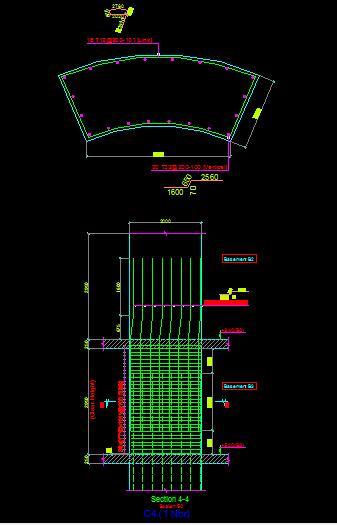
5) Type 12: Shape of the column in
type 12 is Capsule.
The
variables are:
5.1 Name of the column: column name,
5.2
Number of similar columns: Column Number,
5.3
Max diameter for Bar: value of column steel bar diameter on the curved
side,
5.4
Min diameter for Bar: value of column steel bar diameter on the straight
side,
5.5
Max diameter for link: value of maximum link diameter in the column
reinforcement,
5.6
Number of max bar: total number of steel bars in the column on the curved
side,
5.7
Number of Min bar: total number of steel bars in the column on the straight
side,
5.8
column dimensions: Length of column and Width of column,
5.9
cover plate: value of concrete cover for column,
5.10
spacing: value of space between links,
5.11
Kicker: the value of concrete height above slab after which the column will
start
Kicker = 0 if column start straight from the slab,
5.12
From: level of the lower slab,
5.13
Up to: level of the upper slab,
5.14
H up: height of the elevation above the upper slab,
5.15
Height: Value of floor height,
5.16
Lap: There are two cells. In the first one insert number which is multiplied
with the vertical diameter value to result in the value of vertical bars
overlapping in the second cell automatically,
5.17
starting number of Bar Mark (1st
barmark),
5.18
Plate 1: thickness of lower slab,
5.19
Plate 2: thickness of upper slab,
5.20L0 (For SP1 ) : Tick L0 if there is two spacing regarding the link
reinforcement, insert the value of intensification distance for the link
reinforcement ( the default value = 1/6* Column height ),
5.21 Link: Pick link or tie to choose reinforcement rings
type,
5.22
crank: Pick crank if vertical bars is to be cranked,
5.23
Stopped: Pick stopped if the column is stopped at the upper
slab,
5.24
Lap from table: Pick lap from table if overlapping equal constant value from
given table,
5.25
Lap @ middle: Pick Lap @ middle if overlapping location in the middle of
column's height,
5.26
Crank @ Bottom: Pick Crank @ Bottom if vertical bars is cranked at the level of
lower slab,
5.27
Horizontal Link: Pick Horizontal Link if there
is links reinforcement along the other side of column ( the long side
),
5.28
STG: Pick STG if the overlapping is staggered one by one not in the same
location ( with difference of one overlap between each two following
bars).
Input File for Type 12 :
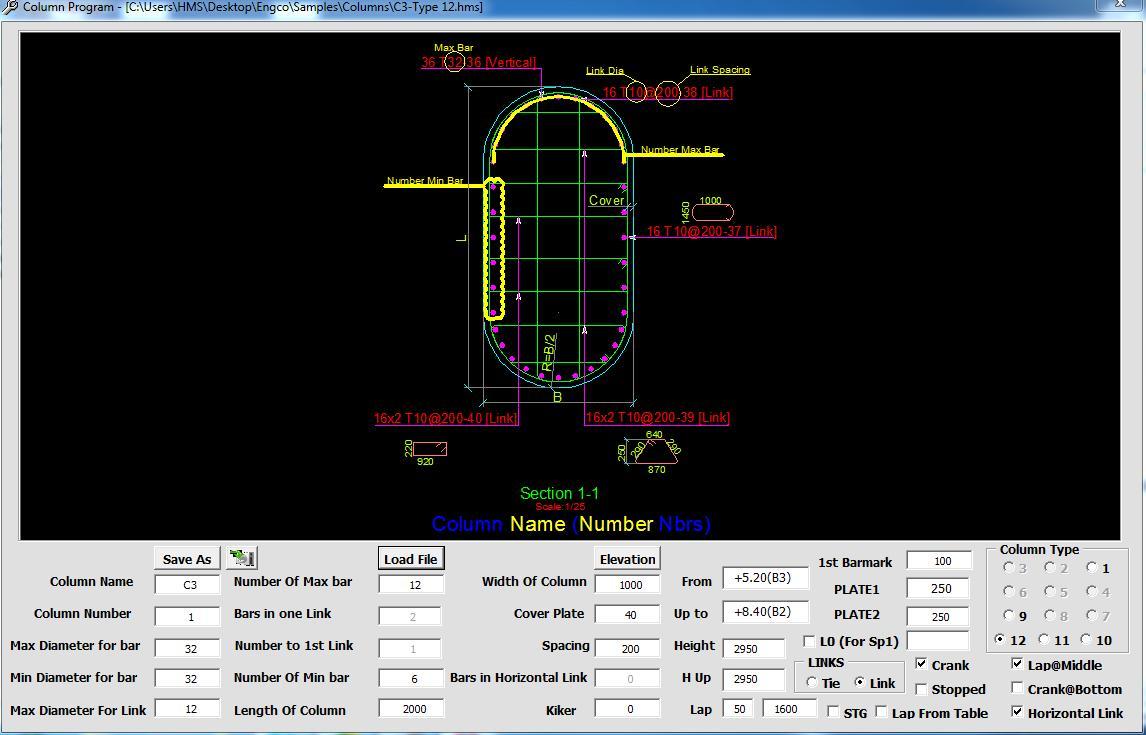
Output file for Type 12 :
